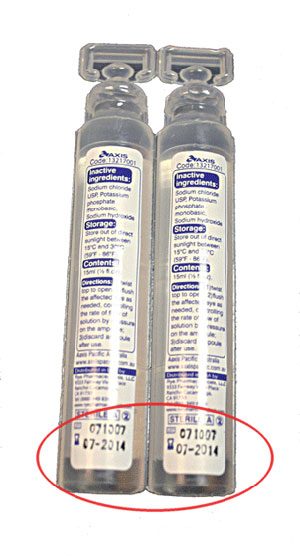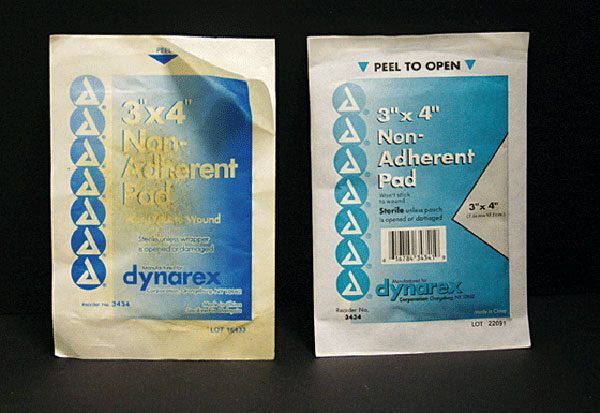Most divers appreciate that first aid and oxygen kits are essential equipment. However, not everyone considers that many of the contents are perishable and need to be replaced periodically. Regardless of the size or type of your oxygen unit or first aid kit, a regular inspection (at least annually) is imperative.
Some items are not marked with a specific expiration date, so deciding when it is appropriate to replace them is not always clear. With proper care, some durable items can last for many seasons. DAN offers update kits and refill packs to keep your emergency gear fully functional, but sometimes your kit may need just a once-over and a few replacement items. Here are some tips for keeping your oxygen unit or first aid kit well-stocked and ready to use.
Container
The best place to start is the container that holds your supplies. What is its general appearance? Inspect it for any damage. Is the zipper (if so equipped) intact, and does it open and close easily? If the container is plastic or metal, inspect it for cracks, breaks or rust. Are the hinges and latches intact and functional? If it has an o-ring seal, make sure it is in place and undamaged. When you open the kit there should not be any foul or unusual odor resulting from mildew. A clean, well-maintained kit is not just a matter aesthetics; it helps provide the injured person you are assisting with a level of confidence. If your kit looks like it’s been sitting untouched on a boat for years, it probably needs cleaning or replacing.

Medications
Medications are the most convenient in terms of knowing when to replace them. This includes any pills, creams, antiseptic wipes, irrigation or eyewash solutions. Essentially, if it comes in a single dose packet, multi-dose tube or bottle, it has an expiration date on it. The dates are usually found on one end of the packets or tubes. With bottles you may have to hunt for it as the location of the date varies. Typically the date is expressed as month/year. The dates generally indicate how long the manufacturer is confident in the product’s effectiveness and/or sterility provided the contents have been stored properly. People often ask whether the contents are good until the end of the month indicated or if they expire at the beginning of the month; this is a somewhat immaterial question. The better question is whether the item is likely to expire before the next time you will need it or before the end of dive season; if so, replace it.

Dressings and Bandages
Dressing, bandaging and bleeding-control supplies can be more problematic than other supplies. Most kits contain both sterile and non-sterile versions of gauze pads and rolls. Typically, there are no expiration dates on the sterile versions. To begin inspection, separate the sterile and non-sterile supplies. Evaluate any non-sterile gauze pads or rolls for the smell of mildew, any discoloration or signs of disintegration. If there is any doubt, replace the items. The sterile versions require a little more detailed inspection, starting with a look at the package itself.

- Sterile gauze pads (such as 4x4s, 2x2s, eye pads, abdominal pads, etc.) come in opaque packages. Inspect the package for signs of faded printing, water spots, yellowing or damage. Generally the packaging has adhesive around the outside edge to seal it closed with one corner or edge that is not completely sealed to facilitate opening. If the seal is open or compromised, do not consider the contents sterile. If the pad is clean and does not warrant disposal, you can add the pad(s) to the non-sterile supply (take care to note this on the packaging of the pad).
- Adhesive strip bandages should undergo a similar inspection of the seal and packaging; however, in this case, if the seal or package is compromised or damaged, replace the bandage.
- Rolls of sterile gauze are usually packaged with clear plastic on one side, sometimes referred to as a “blister” package. As with gauze pads, check the seal and also look at the clear side. If there is any yellowing, staining or signs of condensation on the inside of the package, replace the roll. If the seal is compromised, but the roll is clean, dry and otherwise acceptable, it can still be used as non-sterile gauze.
- Adhesive tape is another item that needs inspection. If you pick up the roll of tape and the surface without adhesive is slimy, sticky or leaves a residue on your fingers, replace it. If you do not find any of these issues, inspect it for cleanliness, yellowing, damage and check whether the adhesive is still viable. Sometimes the cardboard that the tape is wrapped around can deteriorate due to moisture; if the cardboard is not firm or there is any evidence of water damage, it is time for a new roll.
- Elastic bandaging (ACE® Wraps), Steri-Strips®, butterfly bandages or triangular bandages should be inspected for cleanliness, discoloration or damage. Where applicable, check the integrity of the adhesive. You can use the same general inspection criteria for any commercially made splints. Look for rust on safety pins included with the triangular bandages. If they appear rusty, you probably want to replace them. Inspect, clean and disinfect your oronasal mask and its case. If it has a balloon-type seal, ensure it is still adequately inflated.
Tools
- Penlights, otoscopes and flashlights should have their batteries replaced annually. Some styles of penlights are disposable and should be replaced every year.
- Inspect scissors or shears for any signs of rust, corrosion or other defects. If you lubricate them use any lubricant sparingly. Surface rust can be cleaned. Residue from adhesive tape should be cleaned with an appropriate solvent. Remember scissors or shears lose their value if they are dull. To confirm sharpness and strength, cut a piece of tape and/or a gauze pad that is folded to double its thickness. Any additional equipment such as a stethoscope, blood pressure cuff or thermometer should be checked for cleanliness, function and any defects.
A methodical and critical approach to inspecting these items will serve you well. The time invested in the inspection and restocking of items is invaluable. A side benefit is that you will re-familiarize yourself with the contents you already have. This allows the opportunity to add or remove items according to need. Ensuring your oxygen and first aid supplies are clean and ready to use is an integral element of dive safety planning.